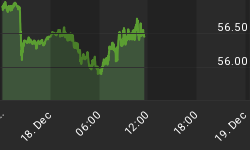Trading in the financial markets has been light so far this week ahead of Friday's U.S. Non-Farm Payroll Report. Traders seem to be willing to attempt to establish an early trend only to have it fizzle by mid-morning on low volume throughout the day.
A good example of this is yesterday's June E-mini S&P 500. This market is in an uptrend and demonstrated its strong bias to the upside with a gap-opening on Monday. Yesterday it started flat, but attracted buyers following a better than expected housing number. The ensuing rally could barely eke out a small rise above the previous day's high. So while the trend continued by posting a new higher-high, the lack of follow-through to the upside following the good news was an indication that this market may be getting top-heavy.
This type of trading is expected to continue over the next two days as investors shy away from committing too much to a position. Day-traders on the other should welcome the volatility and the sudden shift in directions.
The same type of trading action is occurring in the Treasury futures market. Despite the build-up of negative news over the past two-weeks, this week traders seem content with holding both Treasury Bonds and Treasury Notes in a tight range while lightening up on positions established in the direction of the downtrend.
Tuesday's reversal bottom in the June Treasury Notes is a good example of traders lightening up on the short-side. Although technically the closing price reversal bottom could attract follow-through buying today, there has been no change in the fundamentals to think this bottom could develop into something major. Fundamentally, there is still too much supply on the market, and the Fed's plan to buy back government assets remains flawed.
The U.S. Dollar is stronger this morning, but it looks more like profit-taking than the start of a trend reversal. Without any strong verbal or actual support from the government, the world seems to be content with dumping the Dollar on any hint of an improvement in the U.S. economy. While much of the recent loss in the Dollar has been created by investor sentiment rather than hard numbers, the way of least resistance in the Dollar remains to the downside. This condition is likely to continue until someone from the Treasury or the Fed speaks up to defend the Dollar.
The rally in August Gold seems to be running out of gas as this market nears the contract high. Gold continues to move inversely to the Dollar while at the same time investors seem to be reluctant to buy the high tick. Bullish investors having been burned twice in the past year trying to push this market above $1000 seem to be a little hesitant to buy at current levels. This could be signaling that a substantial correction may be needed to attract fresh buying interest.
July Crude Oil continues to hover around the $70 per barrel mark. This was a number talked about in early May as being a fair price for oil Russia, Iran and Venezuela had set this price as an upside objective weeks ago so do not be surprised if the buying begins to dry up as we near this level.
Oil speculators have to be careful not to drive this market too much above $70 as this will most likely lead to $3.00 gasoline. If gasoline gets too high then it may begin to hurt the consumer in the pocketbook as well as do damage to the corporate bottom line. Consumers need to begin spending their money to help revive the economy. High gasoline prices could damage the current developing economic growth.















